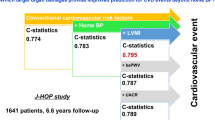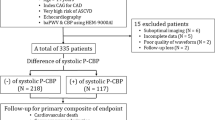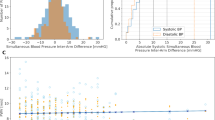Abstract
Aortic blood pressure (BP) and 24-h ambulatory BP are both better associated with target organ damage than office brachial BP. However, it remains unclear whether a combination of these two techniques would be the optimal methodology to evaluate patients’ BP in terms of left ventricular diastolic dysfunction (LVDD) prevention. In 230 participants, office brachial and aortic BPs were measured by a validated BP monitor and a tonometry-based device, respectively. 24-h ambulatory brachial and aortic BPs were measured by a validated ambulatory BP monitor (Mobil-O-Graph, Germany). Systematic assessment of patients’ LVDD was performed. After adjustment for age, gender, hypertension and antihypertensive treatment, septum and lateral E/Ea were significantly associated with office aortic systolic BP (SBP) and pulse pressure (PP) and 24-h brachial and aortic SBP and PP (P⩽0.04), but not with office brachial BP (P⩾0.09). Similarly, 1 standard deviation in SBP was significantly associated with 97.8±20.9, 86.4±22.9, 74.1±23.3 and 51.3±22.6 in septum E/Ea and 68.6±20.1, 54.2±21.9, 37.9±22.4 and 23.1±21.4 in lateral E/Ea, for office and 24-h aortic and brachial SBP, respectively. In qualitative analysis, except for office brachial BP, office aortic and 24-h brachial and aortic BPs were all significantly associated with LVDD (P⩽0.03), with the highest odds ratio in 24-h aortic SBP. Furthermore, aortic BP, no matter in the office or 24-h ambulatory setting, showed the largest area under receiver operating characteristic curves (P⩽0.02). In conclusion, 24-h aortic BP is superior to other BPs in the association with LVDD.
This is a preview of subscription content, access via your institution
Access options
Subscribe to this journal
Receive 12 digital issues and online access to articles
$119.00 per year
only $9.92 per issue
Buy this article
- Purchase on Springer Link
- Instant access to full article PDF
Prices may be subject to local taxes which are calculated during checkout




Similar content being viewed by others
References
Abhayaratna WP, Barnes ME, O'Rourke MF, Gersh BJ, Seward JB, Miyasaka Y et al. Relation of arterial stiffness to left ventricular diastolic function and cardiovascular risk prediction in patients>or =65 years of age. Am J Cardiol 2006; 98: 1387–1392.
Abhayaratna WP, Srikusalanukul W, Budge MM . Aortic stiffness for the detection of preclinical left ventricular diastolic dysfunction: pulse wave velocity versus pulse pressure. J Hypertens 2008; 26: 758–764.
Zhang Y, Li Y, Liu M, Sheng CS, Huang QF, Wang JG . Cardiac structure and function in relation to cardiovascular risk factors in Chinese. BMC Cardiovasc Disord 2012; 12: 86.
Zhang Y, Li Y, Ding FH, Sheng CS, Huang QF, Wang JG . Cardiac structure and function in relation to central blood pressure components in Chinese. J Hypertens 2011; 29: 2462–2468.
Lekakis JP, Zakopoulos NA, Protogerou AD, Kotsis VT, Papaioannou TG, Stamatelopoulos KS et al. Cardiac hypertrophy in hypertension: relation to 24-h blood pressure profile and arterial stiffness. Int J Cardiol 2004; 97: 29–33.
Roman MJ, Okin PM, Kizer JR, Lee ET, Howard BV, Devereux RB . Relations of central and brachial blood pressure to left ventricular hypertrophy and geometry: the Strong Heart Study. J Hypertens 2010; 28: 384–388.
O'Brien E, Asmar R, Beilin L, Imai Y, Mallion JM, Mancia G et al. European Society of Hypertension recommendations for conventional, ambulatory and home blood pressure measurement. J Hypertens 2003; 21: 821–848.
Weber T, Wassertheurer S, Rammer M, Maurer E, Hametner B, Mayer CC et al. Validation of a brachial cuff-based method for estimating central systolic blood pressure. Hypertension 2011; 58: 825–832.
Wilkinson IB, McEniery CN, Cockcroft JR . Central blood pressure estimation for the masses moves a step closer. J Hum Hypertens 2010; 24: 495–497.
Protogerou AD, Smulyan H, Safar ME . Closer to noninvasive out-of-office aortic blood pressure assessment: a time to think and act. Hypertension 2011; 58: 765–767.
Protogerou AD, Argyris A, Nasothimiou E, Vrachatis D, Papaioannou TG, Tzamouranis D et al. Feasibility and reproducibility of noninvasive 24-h ambulatory aortic blood pressure monitoring with a brachial cuff-based oscillometric device. Am J Hypertens 2012; 25: 876–882.
Protogerou AD, Argyris AA, Papaioannou TG, Kollias GE, Konstantonis GD, Nasothimiou E et al. Left-ventricular hypertrophy is associated better with 24-h aortic pressure than 24-h brachial pressure in hypertensive patients: the SAFAR study. J Hypertens 2014; 32 (9): 1805–1814.
Stergiou GS, Tzamouranis D, Protogerou A, Nasothimiou E, Kapralos C . Validation of the Microlife Watch BP Office professional device for office blood pressure measurement according to the International protocol. Blood Press Monit 2008; 13: 299–303.
Papaioannou TG, Protogerou AD, Stamatelopoulos KS, Vavuranakis M, Stefanadis C . Non-invasive methods and techniques for central blood pressure estimation: procedures, validation, reproducibility and limitations. Curr Pharm Des 2009; 15: 245–253.
Jones CR, Taylor K, Chowienczyk P, Poston L, Shennan A . A validation of the Mobil O Graph (version 12) ambulatory blood pressure monitor. Blood Press Monit 2000; 5: 233–238.
Franssen PML, Imholz BPM . Evaluation of the Mobil-O-Graph new generation ABPM device using the ESH criteria. Blood Press Monit 2010; 15: 229–233.
Weiß W, Tölle M, Zidek W, van der Giet M . Validation of the mobil-O-Graph: 24 h-blood pressure measurement device. Blood Press Monit 2010; 15: 225–228.
Wassertheurer S, Kropf J, Weber T, van der Giet M, Baulmann J, Ammer J et al. A new oscillometric method for pulse wave analysis: comparison with a common tonometric method. J Hum Hypertens 2010; 24: 498–504.
Luzardo L, Lujambio I, Sottolano M, da Rosa A, Thijs L, Noboa O et al. 24-h ambulatory recording of aortic pulse wave velocity and central systolic augmentation: A feasibility study. Hypertens Res 2012; 35: 980–987.
Weis W, Gohlisch C, Harsch-Gladisch C, Tolle M, Zidek W, van der Giet M . Oscillometric estimation of central blood pressure: validation of the Mobil-O-Graph in comparison with Sphygmocor device. Blood Press Monit 2012; 17: 128–131.
Nunan D, Wassertheurer S, Lasserson D, Hametner B, Fleming S, Ward A et al. Assessment of central haemomodynamics from a brachial cuff in a community setting. BMC Cardiovasc Disord 2012; 12: 48.
Lang RM, Bierig M, Devereux RB, Flachskampf FA, Foster E, Pellikka PA et al. Recommendations for chamber quantification. Eur J Echocardiogr 2006; 7: 79–108.
Paulus WJ, Tschöpe C, Sanderson JE, Rusconi C, Flachskampf FA, Rademakers FE et al. How to diagnose diastolic heart failure: a consensus statement on the diagnosis of heart failure with normal left ventricular ejection fraction by the Heart Failure and Echocardiography Associations of the European Society of Cardiology. Eur Heart J 2007; 28: 2539–2550.
Nagueh SF, Appleton CP, Gillebert TC, Marino PN, Oh JK, Smiseth OA et al. Recommendations for the evaluation of left ventricular diastolic function by echocardiography. Eur J Echocardiogr 2009; 10: 165–193.
Kane GC, Karon BL, Mahoney DW, Redfield MM, Roger VL, Burnett JC Jr . Progression of left ventricular diastolic dysfunction and risk of heart failure. JAMA 2011; 306: 856–863.
Lanier GM, Vaishnava P, Kosmas CE, Wagman G, Hiensch R, Vittorio TJ . An update on diastolic dysfunction. Cardiol Rev 2012; 20: 230–236.
de Luca N, Asmar RG, London GM, O'Rourke MF, Safar ME, REASON Project Investigators. Selective reduction of cardiac mass and central blood pressure on low-dose combination perindopril/indapamide in hypertensive subjects. J Hypertens 2004; 22: 1623–1630.
Protogerou AD, Stergiou GS, Vlachopoulos C, Blacher J, Achimastos A . The effect of antihypertensive drugs on central blood pressure beyond peripheral blood pressure. Part II: Evidence for specific class-effects of antihypertensive drugs on pressure amplification. Curr Pharm Des 2009; 15: 272–289.
London GM, Asmar RG, O'Rourke MF, Safar ME, REASON Project Investigators. Mechanism(s) of selective systolic blood pressure reduction after a low-dose combination of perindopril/indapamide in hypertensive subjects: comparison with atenolol. J Am Coll Cardiol 2004; 43: 92–99.
Williams B, Lacy PS, Thom SM, Cruickshank K, Stanton A, Collier D et alCAFE Investigators Anglo-Scandinavian Cardiac Outcomes Trial Investigators CAFE Steering Committee and Writing Committee. Differential impact of blood pressure-lowering drugs on central aortic pressure and clinical outcomes: principal results of the Conduit Artery Function Evaluation (CAFE) study. Circulation 2006; 113: 1213–1225.
Avolio AP, Van Bortel LM, Boutouyrie P, Cockcroft JR, McEniery CM, Protogerou AD, Roman MJ et al. Role of pulse pressure amplification in arterial hypertension: experts' opinion and review of the data. Hypertension 2009; 54: 375–383.
Acknowledgements
We thank all the investigators and patients who participated in this study.
Author information
Authors and Affiliations
Corresponding author
Ethics declarations
Competing interests
The authors declare no conflict of interest.
Rights and permissions
About this article
Cite this article
Zhang, Y., Kollias, G., Argyris, A. et al. Association of left ventricular diastolic dysfunction with 24-h aortic ambulatory blood pressure: the SAFAR study. J Hum Hypertens 29, 442–448 (2015). https://doi.org/10.1038/jhh.2014.101
Received:
Revised:
Accepted:
Published:
Issue Date:
DOI: https://doi.org/10.1038/jhh.2014.101
This article is cited by
-
Ambulatory monitoring of central arterial pressure, wave reflections, and arterial stiffness in patients at cardiovascular risk
Journal of Human Hypertension (2022)
-
Central Blood Pressure Waves Assessment: A Validation Study of Non-invasive Aortic Pressure Measurement in Human Beings
High Blood Pressure & Cardiovascular Prevention (2020)
-
Association of left ventricular structural and functional abnormalities with aortic and brachial blood pressure variability in hypertensive patients: the SAFAR study
Journal of Human Hypertension (2017)
-
How to Measure 24-hour Central Blood Pressure and Its Potential Clinical Implications
High Blood Pressure & Cardiovascular Prevention (2017)
-
Ambulatory arterial stiffness in chronic kidney disease: a methodological review
Hypertension Research (2016)



